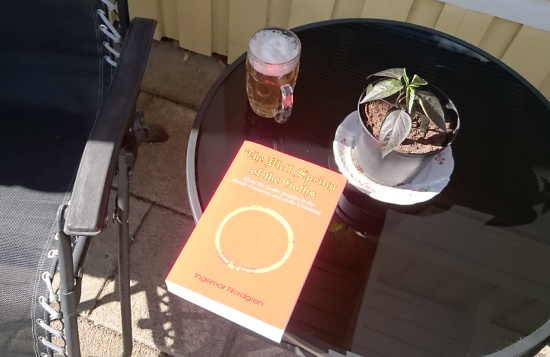
The question: “Where was the origin of the Goths?” is obviously not well put. Since we will never find out why they came to be called Goths, it should be hard for us to pin down the time and place where this appellation stuck.
Our main source is Jordanes, who wrote Getica in Constantinople ca 551 CE. He does not raise the question about a “the origin“, but simply start from the point in time where, we have to suppose, he considered his information to be acceptably reliable.
Ex hac igitur Scandia insula quasi officina gentium aut certe velut vagina nationum cum rege suo nomine Berig, Gothi quondam memorantur egressi.
So, from this island Scandia, as if from a folk-factory or really like a vagina of nations, with a king whose name was Berig, the Goths once mentioned came forth.
Ingemar Nordgren’s book The Wellspring of the Goths seeks to prove Jordanes right, in the face of opposition, starting from a hypothesis saying:
The original connection between the different Gothic tribes is the common cult.
Nordgren holds a PhD and for better or for worse treats every subject like doctors do when they smalltalk between lectures. It really gave me flashbacks from the time when I attended university. He shows an unsatisfiable interest in Old Nordic mythological figures and takes every chance to digress and tell us about this or that rune stone or saga. However, unless the reader knows a great deal of Germanic history beforehand, it will be impossible to keep track of how these figures relate chronologically, or how they shed light on the hypothesized cultic league.
Whether the league was cultic or not, Nordgrens curiosity inspired him to produce a rather unique coverage of what the community knows about the Goths connection with Scandinavia and the Vistula area. Pages 186-263 deals with archelogy in both Scandinavia(Eva Weiler) and Poland(Jerzy Okulicz-Kozaryn).
The book is 549 pages + introduction, bibliography and index. It is written in English, except where it quotes works in, for example German, or where Nordgren’s Swedish shines through. It seems it wasn’t proofread.
If you cannot afford to buy it, you will find some of the treated information (except the archeology) discussed on the Gothic list.
The book is available from, among others:
Bokus
McNally-Robinson and
Blackwell.
